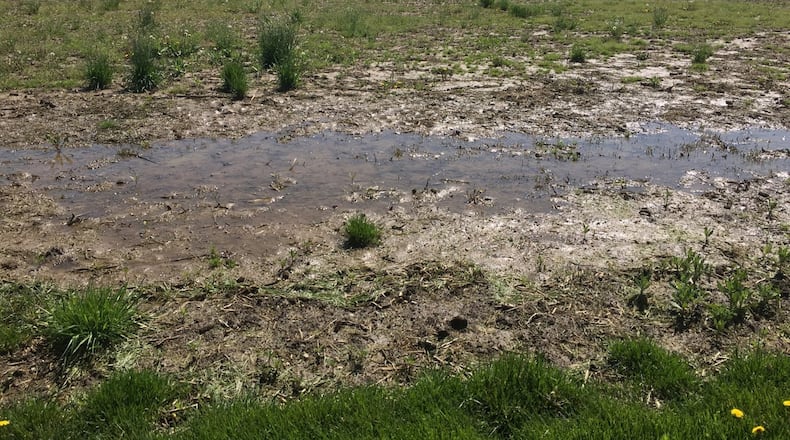“The stress level is extremely high. Patience is running thin. But there is still a possibility depending on the weather that we can have decent crops. Maybe not our top yields, but we can still have decent crops,” said Montgomery County’s OSU extension educator Suzanne Mills-Wasniak.
» RELATED: Kroger sells off popular ice cream and tea brand
Over the last week there were a few dry days that some farmers were able to get into the fields, but Ohio Farm Bureau spokesman Joe Cornely said there probably wasn’t much planted. It depends on the combination of drainage, equipment and weather area farmers have, He said.
Greene County farmer Craig Corry has planted 25 to 30 percent of his land and Clark County farmer Brian Harbage has planted 10 percent, but Butler County farmer Rita Biser said her family farm has only been able to spray and apply anhydrous.
In Montgomery County, a “negligible” amount of seed has been planted, Mills-Wasniak said.
Prime planting season is generally between April 15 and May 10, according to area farmers. After May 15, farmers begin losing an average one bushel of corn per acre per day, said Sam Custer, Darke County’s OSU extension educator.
The weather pattern has been especially difficult this year as warm, sunny days start drying out fields only to be interrupted by showers again for the drying process to restart. Harbage said he’s only been able to plant two days this season, April 17 and May 8.
And the wet weather is expected to stick around with rain possible Sunday and Monday before a clear up Tuesday, according to WHIO Storm Center 7 Meteorologist Kirstie Zontini’s five-day forecast.
» RELATED: Kraft will pay for your babysitter on Mother's Day
It could take five days of ideal weather for some fields to dry enough to plant, Harbage said.
“Every day that a farmer is able to plant, that’s a good day for that farmer,” Corry said. “They’re going to look for every opportunity. Any field that’s dry enough to go, they’re going to plant it.”
Those same farmers are stocking up on fertilizer and doing precautionary maintenance to make sure when a field is dry enough they’re ready,” he said.
If the weather doesn’t dry up in time to follow planned planting schedules, Cornely said most farmers still have options. They can switch to a different variety of corn that can mature quicker or one that will mature later in the harvest season. They can also change to soybeans which have more opportunity than corn when planted later.
Many also have planting insurance that can offset some of the costs, he said.
Winter wheat remains in fair condition, but weed pressures are a growing concern among the wet conditions and could soak up more of the nutrients meant for crops this year, said Storm Center 7 Meteorologist Jesse Maag.
» BIZ BEAT: If you're not 21, you can't buy tobacco, e-cigs at area giant retailer
The weather concerns add to a yearslong downturn in the commodities. Farmers could get $7.98 for a bushel of soybeans and $3.38 for corn Friday, down from $14.13 and $6.25 respectively around this time in 2012, according to NASDAQ.
“You’re looking at prices that for many farmers are below break even. You’re looking at this current trade dispute hammering the grain markets, and so on the economic side that’s a huge worry for farmers,” Cornely said. “And then you throw in the fact that they can’t get their crop in the group and this is not a good time to be a farmer.”
The planting window has gotten smaller in recent years, Cornely said, so farmers are putting in more drain tile, getting new machinery and changing planting habits to ease concerns in the long run.
But some of those farmers will end up going out of business or giving up if the downturn continues, Harbage said.
“While farmers are feeling the pain directly, it’s the rural economy as a whole. The people who work in factories that build farm equipment, the local Ford dealer, the guy trying to sell tickets to the new Avengers movie. That income gets circulated through the local community and when farm incomes are hit, whether it’s because of a trade war, or bad weather or low prices, that whole rural economy is going to feel the pinch,” Cornely said.
FIVE FAST READS
• How a Dayton innovation company is growing
•Feeling sad? Mad? Burger King has an unhappy meal for you
• Local Burger King restaurant closing at end of month
• Here's how you can win free White Castle for a year
By the numbers
10: The average number of days farmers need to plant
2: Percent of corn that’s been planted
27: Percent of corn usually planted by this time
1: Percent of soybeans that have been planted
9: Percent of soybeans usually planted by this time
About the Author
